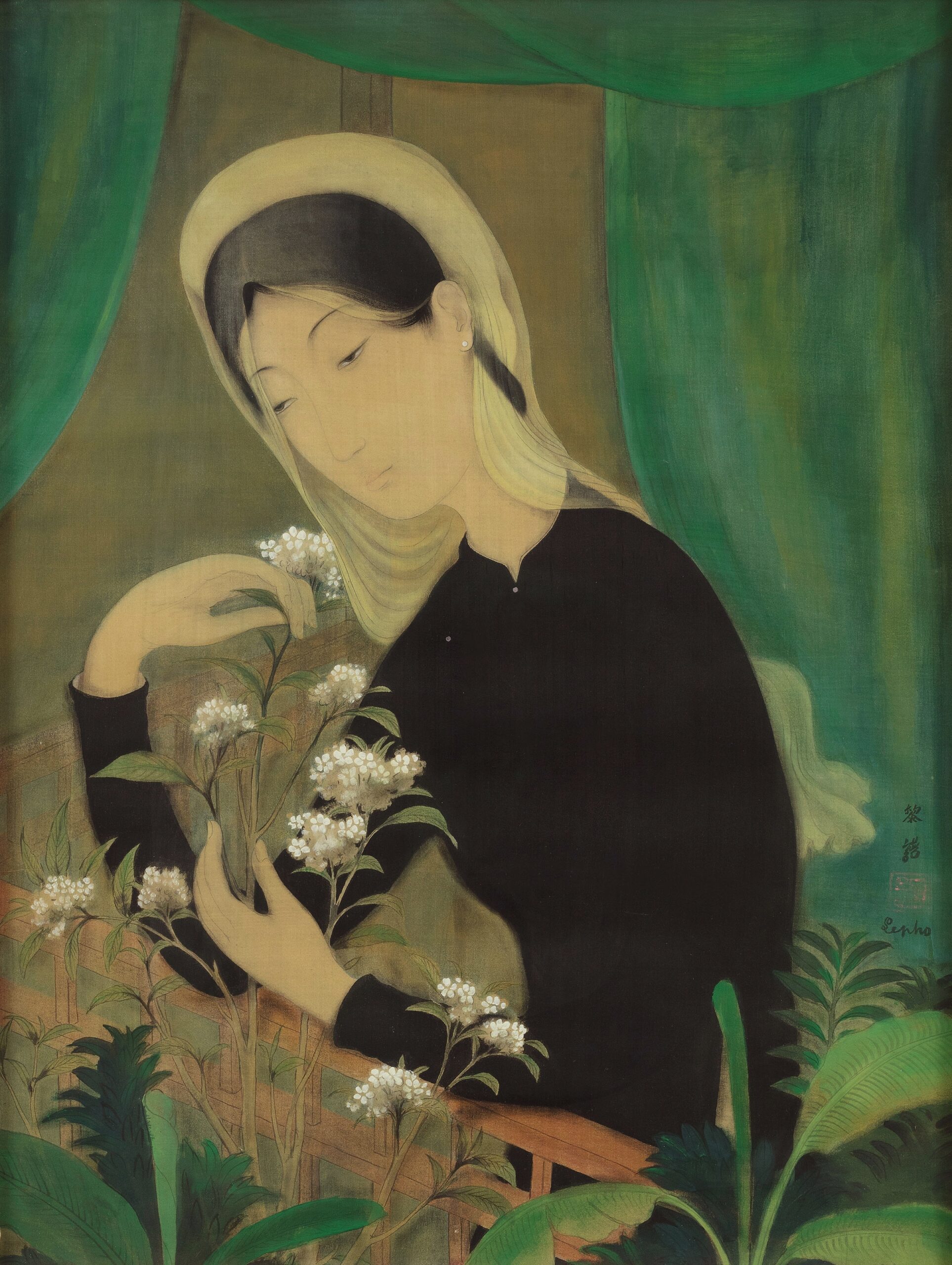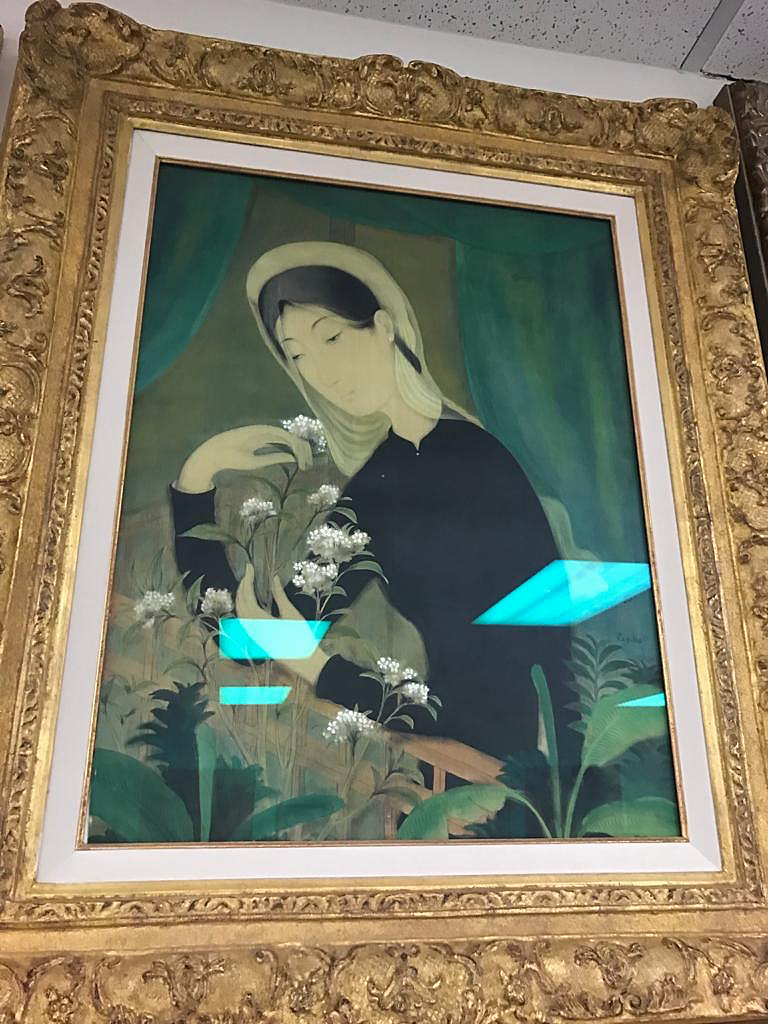
Le Pho (1907-2001)
Nostalgie (Nostalgia)
signed ‘Le pho’ and signed again in Chinese (lower right)
ink and gouache on silk
60 x 45 cm. (23 5/8 x 17 3/4 in.)
Painted in 1938
one seal of the artist
Provenance
Collection of Mr Tuan H Pham, California, USA
Christie's Hong Kong, 26 May 2019

The year 1938 no doubt holds great significance and is a pinnacle in Le Pho’s expression and painting. Indeed, when he returned to Paris in 1937 for the second time (after his initial first stay in 1931-32), the migration from his native Vietnam to Paris and the subsequent clash and confrontation of ideals of Vietnam-France inspired him through his work which was empowered by an impeccable technique.
Furthermore, two titular words stand out: nostalgia and conquest would be the driving force through Le Pho’s life: the gift of an endless source of inspiration enhanced by his geographical and mental being to feed his unique and irreplaceable work. This awareness goes well beyond his major themes (the longing for his birth land, the mythologized woman) and well beyond his painting techniques - oil on canvas, gouache and ink on silk, and lacquer which he rarely executed.
The painting Nostalgie (Lot 44) we are proud to present here is clearly an extraordinary work: a milestone in the master’s creation.
When observing the painting, the poet Nguyen VanHanh (?-1018) comes to mind: We (liveing beings) are as ephemeral as lightning / (As for the trees), in the spring thousand blossom, when autumn comes, all dry out / Do not fear, let's life be with its moments of prosperity and decline / As all these moments are so brief, so fragile such as morning dew on the tip of a green leaf.
Indeed, this work uses all the same classical elements usually found in all Le Pho’s paintings at that time: the fine features of the lady’s face is diaphanous, as is her headdress and her black ao dai which was a rare and unusual colour, all set in an opulent interior in her native land of Tonkin. In this particular work, and what makes it also outstanding, is the representation of blossoming jasmine flowers, a symbol of separation delicately embraced by the lady.
The contrast between the black dress and the white flowers is an eloquent and emotional metaphor for his departure from his homeland to explore and take on a new life in Paris, La Ville-lumiere (the City of Light). In front of the powerful grace of the Tonkinese lady presented here, her nostalgic and sensual facial traits succumb to the power of her gesture: she caresses the wild flowers more than she intends to grasp them. Her hand surrounds graciously the flowers already gathered and highlights the very subtle and sensual relationship between the lady and the blossoming jasmine flowers.
While painting this work around 1938, he probably had already made up his mind: the choice was to stay permanently in France, a country where he was welcomed with elegance and success in 1931, when he was Victor Tardieu’s assistant during the Colonial Exhibition. His contribution then was immense and essential, and was also recognized during the Exposition Universelle de Paris in 193. It is again in Paris that everything will be decided, judged and declared - Montparnasse is the world centre of visual art, where all the great masters of the time meet each other and mingle in an atmosphere of permanent quest for the absolute. On the other side of the world, in Vietnam, Tardieu, his mentor, passed away the previous year (1937). Evariste Jonchere then became the head of the School of Fine-Art of Hanoi but in a way not all the artists approved of this change.
Le Pho was an orphan for a long time, his true field of investigation and his real artistic homeland was going to be France where he would be welcomed with pride but also demands from the greater public sphere. The great Vietnamese painter would never return to his homeland Vietnam.
He was then young man at 31, ambitious in his work, trusting his destiny, and with the modesty only known to the greatest, created this beautiful artwork presented here. The soft depiction of women were his greatest subjects, undoubtedly showing his love for the feminine subjects, and the reason why of all the female representations in 20th century pictorial art in Vietnam, he offered the most beautiful, elegant and sincere representation of women. By his genius, now universally recognized, he succeeded in making his subject of predilection and a subject of admiration.
A cultured man faithful to Tonkinese thought and culture of the 18th Century, Le Pho’s painting subsequently expresses the same lyrical melancholy we find in the Chinh Phu Ngam - (The Song of the Soldier’s Wife) , written around 1760 by Dang Tran Con:
When you took the road, the apricot tree was not yet in bloom;
You thought you would return towards the blossoming of the peach trees.
Today, the flowers of the peach tree withered and blew away with the Eastern wind, and the pink lotus is lost on the river.
- Dang Tran Con - Chinh Phu Ngam.
Particularly in art, nostalgia is the baggage of the lover.
Jean-François Hubert, Senior Expert, Vietnamese Art










